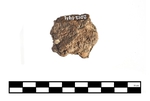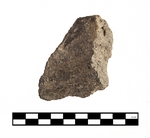Document Content
Conclusion
The excavation of CA 72 during the 2012 season was highly successful: it further clarified the features revealed in CA 70 and CA 71, while also revealing new architectural features. The thin linear rock packings present in CA 70 and CA 71 did not appear in CA 72. CA 72 did, however, have a more robust linear feature of stones twenty to fifty centimeters in length which formed a feature approximately seventy centimeters in width. Included within the feature were large, well-preserved fragments of terra cotta roofing elements and pithos storage containers. This robust feature appears to be a load bearing wall. Because no rock features were found to the east of the load bearing wall, it seems to be the easternmost boundary of any potential building. Further excavation is needed in the surrounding area to confirm that hypothesis, define the area of such a possible building, and determine what function it may have held on Poggio Civitate.
The high concentration of slag and vitrified terra cotta in CA 72 and the surrounding trenches
may indicate that the area was used for metal working on a small scale. Additionally, in CA 72, two crucible fragments, 20120102 and 20120194
, and a bellows fragment, 20120058 , were recovered, though no metal roasting oven was found. Furthermore, the bronze recovered in the area enjoyed a high level of preservation. Perhaps this area played some sort of role in metal production on the site, possibly in relation to the roasting pits found in CA 33, though again further excavation is required to confirm whether metal working was occurring near CA 72.The dating of this area is unclear. There are finds which span three time periods, including an Iron Age spindle whorl, 20120043
, an Orientalizing dragon fibula, 20120069 , and in CA 70 a possible Archaic gorgon hair fragment, 20120112 . These various materials may indicate a long period of habitation in the Civitate A area, which might possibly be associated with the use of the well in CA 42N. Ultimately, more excavation is needed in this area to elucidate the form and function of the rock features uncovered in 2012, as well as their occupation and use.
| Descriptive Attribute | Value(s) |
|---|---|
| Document Type | Trench Book Entry |
| Trench Book Entry Date | 2012-08-09 |
| Entry Year | 2012 |
| Start Page | 227 |
| End Page | 230 |
| Title | Conclusion |
| Descriptive Attribute | Value(s) |
|---|---|
|
Is Part Of
Vocabulary: DCMI Metadata Terms (Dublin Core Terms) |
AEG VI
Vocabulary: Murlo |
Suggested Citation
Ann Elizabeth Glennie. (2017) "AEG VI (2012-08-09):227-230; Conclusion from Europe/Italy/Poggio Civitate/Civitate A/Civitate A72/2012, ID:655". In Murlo. Anthony Tuck (Ed). Released: 2017-10-04. Open Context. <https://opencontext.org/documents/444235b3-e4f5-4db2-8c06-f689d51d30e2> ARK (Archive): https://n2t.net/ark:/28722/k27h1w23f
Copyright License
To the extent to which copyright applies, this content
carries the above license. Follow the link to understand specific permissions
and requirements.
Required Attribution: Citation and reference of URIs (hyperlinks)




















